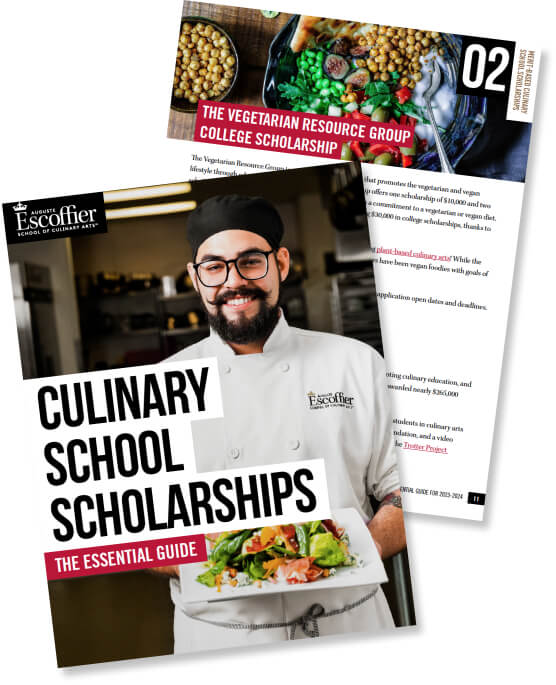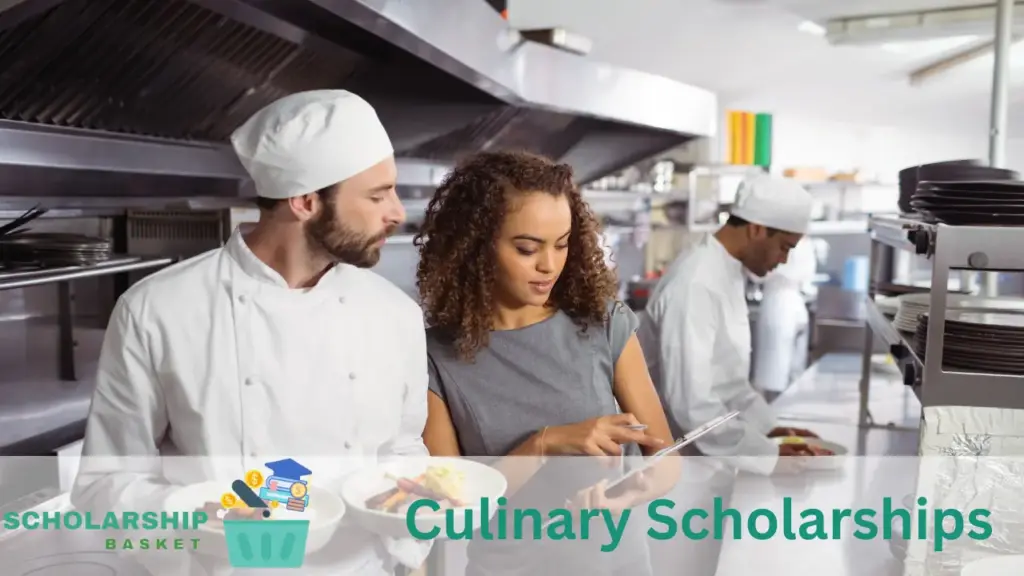I remember the exact moment the aroma hit me. It wasn’t just the smell of garlic sautéing in olive oil, or the sweet promise of caramelizing sugar; it was the smell of possibility. I was standing in my grandmother’s kitchen, a small, bustling universe of flavors and love, watching her transform simple ingredients into magic. That day, a tiny spark ignited within me, a quiet whisper that grew into a roaring flame: I wanted to be a chef. Not just any chef, but one who could tell stories with every dish, who could evoke memories and create new ones, just like Grandma.
The dream, however, came with a hefty price tag. As I researched culinary schools, the numbers on the tuition pages felt less like figures and more like insurmountable mountains. My heart sank. How could I, a young aspiring cook with limited resources, ever hope to afford a world-class culinary education? It felt like my dream was destined to remain just that – a dream, confined to my imagination and my home kitchen.
Then, a flicker of hope. A friend, seeing my dejected face, casually mentioned something about scholarships. "Have you looked into culinary school scholarships?" she asked. The words hung in the air, a lifeline I hadn’t even known existed. Scholarships. The idea was almost foreign to me. I thought they were just for academic whizzes or star athletes. Could there really be scholarships for someone like me, whose passion lay in the alchemy of food?
That question set me on a path, a parallel journey to my culinary aspirations, one filled with research, applications, and a healthy dose of persistence. And I’m here to tell you, from someone who has walked that path and emerged victorious, that culinary school scholarships are not a myth. They are real, they are abundant, and they can absolutely turn your culinary dreams into a tangible reality.
So, what exactly are these magical things called culinary school scholarships? In simple terms, they’re financial awards given to students to help cover the costs of their education. Unlike loans, you don’t have to pay them back. Think of them as investments in your potential, granted by individuals, organizations, or even the schools themselves, who believe in the future of the culinary arts and want to support the next generation of chefs, bakers, restaurateurs, and food innovators. For me, they became the bridge over that financial mountain, allowing me to focus on learning rather than worrying about debt.
Why are these scholarships so important? Well, beyond the obvious financial relief, they represent so much more. They validate your passion. They tell you that others see the fire in your belly, the talent in your hands, and the vision in your mind. For someone like me, who felt a bit lost about how to pursue such an expensive dream, receiving a scholarship was an incredible boost of confidence. It meant I could pursue my education without the crushing burden of student loan debt hanging over my head, allowing me to truly immerse myself in the demanding yet exhilarating world of culinary training. It opens doors, creates opportunities, and removes a significant barrier for many talented individuals who might otherwise never step foot in a professional kitchen classroom.
As I dug deeper, I realized there wasn’t just one type of scholarship; there was a whole buffet of options, each with its own flavor and criteria. It was like discovering a secret menu!
First, there were need-based scholarships. These are awarded to students who demonstrate a genuine financial need. For these, schools and organizations often look at your family’s income and assets to determine how much help you require. This was a big one for me, as my family’s financial situation meant that paying full tuition was simply out of the question.
Then came the merit-based scholarships. These are for students who show exceptional talent or academic achievement. While I wasn’t a straight-A student in every subject, I had a decent academic record, and more importantly, I had a portfolio of my home cooking experiments, photos of dishes I’d created, and even some small catering gigs I’d done for friends and family. Some merit scholarships might look for high GPAs, others for leadership skills, and many in the culinary world look for demonstrated passion and potential in the kitchen. This could be through culinary competitions you’ve participated in, a well-put-together recipe portfolio, or even a compelling essay about your culinary journey. I learned that showing what you’ve already done, even informally, can make a huge difference.
I also stumbled upon scholarships for specific demographics or groups. These could be for women in culinary arts, students from underrepresented minority backgrounds, veterans, or even those pursuing specific culinary niches like pastry or sustainable farming. It’s amazing how many organizations exist to support diverse talents within the food industry.
Many culinary schools themselves offer their own scholarships. These can be institutional grants, dean’s scholarships, or specific departmental awards. When I applied to my top choice school, I made sure to ask their financial aid office about every single scholarship they offered. You’d be surprised how many internal opportunities are available that aren’t widely advertised elsewhere.
Beyond the schools, there are numerous professional culinary organizations and foundations that provide scholarships. I remember researching groups like the James Beard Foundation, the American Culinary Federation (ACF), and various local chef associations. These organizations are dedicated to advancing the culinary profession, and supporting aspiring chefs is a big part of their mission. They often have very specific application windows and requirements, so staying organized was absolutely crucial.
Finally, I discovered local scholarships. These are often overlooked but can be incredibly valuable. Community foundations, local businesses, Rotary clubs, and even restaurant groups in your hometown might offer scholarships to local students. These often have less competition than national scholarships, increasing your chances of success. I found one through a local restaurant owner who was passionate about fostering young talent in our area – a true hidden gem!
So, where do you even begin to find these opportunities? It can feel like searching for a needle in a haystack, but with a systematic approach, it becomes much more manageable.
My first stop was always the financial aid office of the culinary schools I was interested in. They are goldmines of information, not just about their own scholarships but often about external ones they know their students have successfully applied for. Don’t be shy; schedule a meeting or send an email. Ask direct questions: "What scholarships are available specifically for students in my program?" "Are there any scholarships for first-year students?" "Do you have a list of external scholarship resources?"
Next, I spent countless hours on online scholarship databases. Websites dedicated to college scholarships often have filters for specific fields of study, like culinary arts. While some of these can be overwhelming, a focused search using keywords like "culinary scholarships," "food service scholarships," or "hospitality scholarships" can yield a good list of potential matches. I made a spreadsheet to keep track of everything – the scholarship name, deadline, requirements, and a link to the application. This became my bible during the application season.
As I mentioned, professional culinary organizations are fantastic resources. Groups like the James Beard Foundation, the American Culinary Federation (ACF), the National Restaurant Association Educational Foundation (NRAEF), and Women Chefs & Restaurateurs (WCR) all have scholarship programs. Their websites are usually very clear about eligibility and application processes.
Don’t forget local community foundations and high school guidance counselors. Even if you’re not fresh out of high school, your old guidance counselor might have a list of local scholarships they keep updated. Community foundations often manage dozens of smaller, local scholarships that are specifically for residents of your area. These are often less competitive and can add up quickly.
Finally, consider restaurant groups or food service companies. Some larger chains or even local, successful restaurants might have philanthropic arms that offer scholarships to aspiring culinary professionals. It never hurts to check their corporate social responsibility pages or inquire directly.
Now, let’s talk about the actual application process. This is where the rubber meets the road, and where my personal story truly began to unfold. It’s a marathon, not a sprint, but every step is worth it.
Research is paramount. Once I found a scholarship that looked promising, I didn’t just skim the surface. I read every single word of the eligibility criteria. Is it for U.S. citizens only? Do I need a certain GPA? Is it for a specific type of culinary program (e.g., certificate vs. degree)? Does it require enrollment in an accredited institution? Missing a single detail could mean wasted effort.
Then came the gathering of documents. This usually included academic transcripts from high school or any previous college, letters of recommendation (I asked my high school cooking teacher, a chef I’d interned for, and my grandmother, who could speak to my lifelong passion), financial statements (for need-based scholarships), and sometimes a resume outlining my culinary experiences, even if they were just volunteer roles or small jobs. Getting these documents together takes time, so I started early. I gave my recommenders plenty of notice and clear instructions on what aspects of my character and skills I wanted them to highlight.
The essay was often the most crucial part for me. This was my chance to tell my story, to convey my passion, and to articulate my dreams. I didn’t just write a generic essay; I tailored each one to the specific scholarship, reflecting on their mission statement and values. For instance, if a scholarship focused on sustainable cooking, I’d talk about my interest in local sourcing and minimizing food waste. If it was about community impact, I’d share my ideas for food education programs. I wrote about my grandmother’s kitchen, the first time I baked a perfect loaf of bread, the joy of feeding people, and my vision for the future of food. I let my personality shine through, making sure it sounded like me, not a textbook. I learned that authenticity resonates. People want to invest in real people with real dreams.
For some merit-based scholarships, a portfolio or even an audition might be required. This could involve submitting photos of your dishes, recipes you’ve developed, or even a video demonstration of your knife skills or a specific cooking technique. While I didn’t have to do a live audition, my collection of food photography and recipes certainly helped strengthen my applications.
And finally, deadlines, deadlines, deadlines! I cannot stress this enough. Missing a deadline, even by an hour, usually means your application is immediately discarded. My spreadsheet with all the dates became my constant companion. I aimed to submit everything at least a week before the actual deadline to avoid any last-minute technical glitches or unforeseen issues.
Sometimes, an interview might be part of the process, especially for larger scholarships or those from specific organizations. This is your chance to shine in person (or via video call). Be prepared to talk about your passion, your goals, and why you believe you deserve the scholarship. Practice answering common questions, and always have a few thoughtful questions of your own ready to ask them.
Looking back, here are the tips that truly made a difference in my scholarship journey:
- Start Early, Stay Organized: This is probably the most important piece of advice. Scholarship searching and applying is a long process. The earlier you start, the more opportunities you’ll find, and the more time you’ll have to craft compelling applications. My spreadsheet was my best friend.
- Read Every Word: I mentioned this before, but it bears repeating. Don’t assume anything. Read all instructions, eligibility criteria, and FAQs thoroughly.
- Tailor Each Application: Don’t use a generic essay for every scholarship. Each organization has its own mission and values. Show them you’ve done your homework and that your goals align with theirs. Make them feel like you’re talking directly to them.
- Proofread Relentlessly: A typo or grammatical error can make you look careless. After I wrote an essay, I’d read it aloud, then use a spell checker, then ask a trusted friend or mentor to read it. Fresh eyes catch mistakes you might miss.
- Ask for Help: Don’t be afraid to ask for letters of recommendation, advice on your essays, or clarification on application requirements. Teachers, mentors, counselors, and even family members can be invaluable resources.
- Apply to Many: It’s a numbers game. Not every scholarship you apply for will result in an award, and that’s okay. The more you apply for, the higher your chances of success. Treat each rejection as a step closer to a "yes."
- Show Your Passion: Let your love for food and cooking shine through in every part of your application. Admissions committees and scholarship panels want to see genuine enthusiasm and dedication. This isn’t just about getting money; it’s about investing in a future chef.
- Be Persistent: There will be moments of frustration, moments where you feel like giving up. Don’t. Every application submitted is an act of hope and determination. Keep pushing forward.
After months of dedicated effort, the emails started trickling in. First, a small local scholarship. Then, a larger one from a national culinary organization. And finally, the big one – a significant award from the culinary school itself, covering a substantial portion of my tuition. When that last email arrived, I remember staring at the screen, tears welling up in my eyes. It wasn’t just money; it was validation. It was an affirmation that my dream, once a distant fantasy, was now within reach.
Stepping into the professional kitchen of culinary school for the first time was surreal. The gleaming stainless steel, the sharp knives, the vibrant ingredients – it was everything I had imagined and more. I was surrounded by fellow students who shared my passion, guided by chef instructors who had mastered their craft. Because of those scholarships, I could fully immerse myself in learning, without the constant worry of how I would pay for the next semester. I focused on mastering knife cuts, understanding flavor profiles, perfecting classic techniques, and experimenting with new ideas. I learned about food science, kitchen management, and the business side of the restaurant industry.
My culinary school scholarship journey wasn’t just about securing funding; it was about learning resilience, organization, and the power of believing in myself. It taught me that sometimes, the biggest obstacles can lead you to discover unexpected paths and resources.
If you’re reading this, and you have that same burning desire to create, to innovate, and to share your love of food with the world, please don’t let the cost of education deter you. Culinary school scholarships are out there, waiting for passionate individuals like you to discover them. It will take effort, dedication, and a good dose of research, but I promise you, it is an incredibly rewarding endeavor.
Your dream of becoming a chef, a baker, a food entrepreneur, or any other culinary professional, is valid and achievable. Start your research today. Gather your documents. Write your story with all the passion you feel for food. Apply to every scholarship that fits. Your culinary journey is just beginning, and with the right support, you can cook up the most incredible future imaginable. Don’t let anything stand between you and the sweet smell of possibility.



